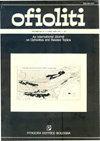The role of MORB and SSZ magma-types in the formation of Jurassic ultramafic cumulates in the Mirdita ophiolites (Albania) as deduced from chromian spinel and olivine chemistry
IF 1.3
4区 地球科学
Q2 GEOLOGY
引用次数: 22
Abstract
Both the Western (WMO) and Eastern (EMO) Mirdita ophiolites include well-developed ultramafic cumulitic sequences. In the WMO, they mainly con- sist of dunites, plagioclase-dunites, plagioclase-wehrlites, and troctolites. In contrast, in the EMO they mainly consist of chromitiferous-dunites, dunites, lher- zolites and olivine-websterites, as well as minor plagioclase-bearing dunites and lherzolites, and troctolites. The main rock-forming minerals in ultramafic cu- mulates are cumulus olivine associated with various inter-cumulus minerals, as well as chromian spinel occurring as both cumulus and inter-cumulus phase. Mg#, FeO/MgO ratios and TiO 2 , Al 2 O 3 concentrations in parental melts were calculated from olivine and spinel compositions. The inferred parental melt compositions indicate that the dunite-troctolite layered series at the mantle tectonite-ultramafic cumulate transition zone in the WMO was derived from a nor- mal-type mid-ocean ridge basaltic (N-MORB) parental melt. In contrast, the dunite-troctolite layered series from the top of the WMO ultramafic cumulitic se- quence was derived from a medium-Ti basaltic (MTB) parental melt originated, in turn, in a nascent forearc setting. The inferred composition of parental melts indicate that chromitiferous dunites, dunites, and lherzolites from the EMO were originated from primary boninitic melts, whereas olivine-websterites were originated from slightly fractionated boninitic liquids. The inferred parental melt compositions plagioclase- bearing dunites and lherzolites, as well as troctolites from the EMO are compatible with an N-MORB type parentage, being the only exception one plagioclase- dunite, which may have derived from a low-Ti tholeiitic melt. Comparison of the ultramafic cumulates from the WMO and EMO indicates that both these units, though to a different extent, have experienced similar and coeval magmatic events. The investigated WMO ultramafic cumulates record N-MORB and MTB magmatic episodes. The investigated EMO ultramafic cumulates testify for boninitic, N-MORB, and very subordinate low-Ti tholeiitic magmatic events. It is therefore concluded that both WMO and EMO were generated in a protoforearc-forearc setting likely initiated nearby an active mid-ocean spreading ridge.从铬尖晶石和橄榄石化学分析推断了MORB和SSZ岩浆类型在Mirdita蛇绿岩侏罗系超基性沉积形成中的作用
米地塔西部(WMO)和东部(EMO)蛇绿岩均包含发育良好的超镁质堆积层序。在世界气象组织中,它们主要由灰长岩、斜长岩-灰长岩、斜长岩-灰长岩和滑石组成。EMO主要由含铬铁矿-泥粒岩、泥粒岩、硅沸石和橄榄辉石组成,还有少量含斜长石的泥粒岩、硅沸石和橄榄岩。超镁铁性铜榴石的主要造岩矿物是与各种积云间矿物伴生的积云橄榄石,以及以积云和积云间相赋存的铬尖晶石。根据橄榄石和尖晶石组成计算母熔体中Mg#、FeO/MgO比值和tio2、al2o3浓度。推断出的母熔体成分表明,WMO地幔构造-超基性堆积过渡带的榴辉岩-橄榄岩层状系来源于非男型洋中脊玄武岩(N-MORB)母熔体。相比之下,来自WMO超基性堆积层序顶部的榴辉岩-橄榄石层序则来自于中钛玄武岩(MTB)母质熔体,反过来又起源于新生的弧前环境。母质熔体的成分推断表明,EMO中含铬铁矿的灰岩质、灰岩质和辉橄榄岩来源于原生的硼岩质熔体,而橄榄-韦氏岩则来源于微分馏的硼岩质液体。推断出的母质熔体成分为含斜长石的褐晶石和辉橄榄岩,以及来自EMO的橄榄岩,与N-MORB型母质相兼容,只有一个斜长石-褐晶石例外,可能来自低钛的拉斑岩熔体。对比WMO和EMO的超镁铁性积累表明,这两个单元虽然程度不同,但都经历了相似的、同时期的岩浆活动。所调查的WMO超岩浆累积记录了N-MORB和MTB岩浆事件。所研究的EMO超镁铁质堆积证明了硼岩质,N-MORB和非常次要的低钛拉斑岩浆事件。因此,WMO和EMO都是在原前弧-前弧环境中产生的,可能起源于活跃的洋中扩张脊附近。
本文章由计算机程序翻译,如有差异,请以英文原文为准。
求助全文
约1分钟内获得全文
求助全文
来源期刊

Ofioliti
地学-地质学
CiteScore
2.40
自引率
7.70%
发文量
1
期刊介绍:
Since 1976, Ofioliti provides an international forum for original contributions and reviews in the field of the geodynamics, petrology, geochemistry, biostratigraphy, stratigraphy, tectonics and paleogeography applied to ophiolitic terrains and modern oceanic lithosphere, including their sedimentary cover. Studies of topics such as geodynamics of the mantle, the evolution of orogens including ophiolites and paleoceanography are also welcome
 求助内容:
求助内容: 应助结果提醒方式:
应助结果提醒方式:


